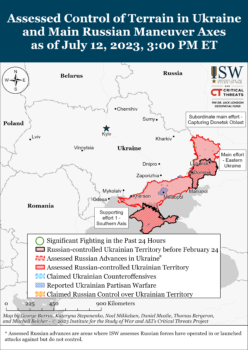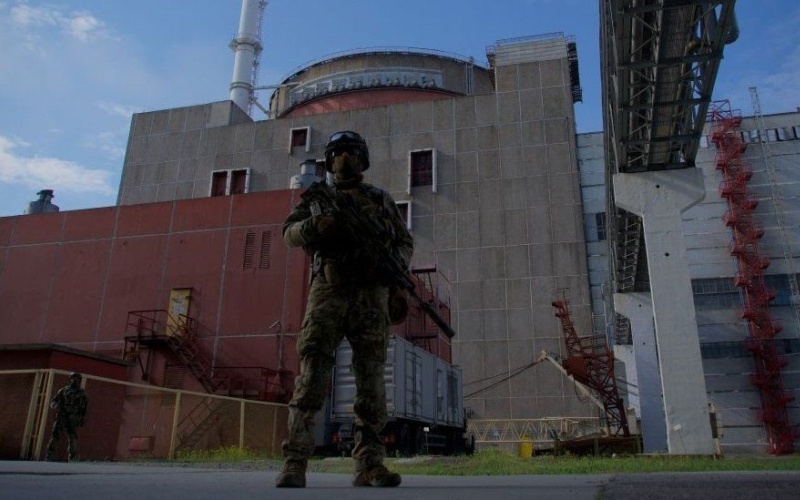A Russian soldier stands guard at the Zaporizhzhia nuclear powr plant in southern Ukraine, May 2022 (Getty)
Tuesday’s Coverage: Russia Damages Historic Cathedral, Destroys Grain Terminal in Odesa

Map: Institute for Study of War
UPDATE 1428 GMT:
UN Human Rights Commissioner Volker Türk has called for Russian accountability for the killing of at least 50 Ukrainian prisoners of war in an explosion in a detention center last year in the Donetsk region in eastern Ukraine.
”The prisoners of war who were injured or died at Olenivka, and their family members, deserve the truth to be known, and for those responsible for breaches of international law to be held accountable,” Türk said in a statement to journalists.
UN experts, who conducted extensive interviews with survivors and analyzed additional information, said they had not identified the specific cause of the explosion. However, they rejected Moscow’s claim that the prison was struck by a US-made HIMARS rocket.
Russia refused access by the experts to Olenivka.
UPDATE 1418 GMT:
Germany and France have opposed the call of five Central European countries for an extension of restrictions of Ukrainian grain exports in their territories.
In April, the European Union permitted Bulgaria, Hungary, Poland, Romania and Slovakia to prohibit sales in their local markets, while keeping transit routes open for Ukrainian grain to cross into other countries.
The arrangement ends on September 15, but the five countries are seeking an extension to the end of the year.
On Monday, Ukraine President Volodymyr Zelenskiy said any extension is “absolutely unacceptable and frankly anti-European”.
UPDATE 1359 GMT:
On the eastern front of their counter-offensive, Ukrainian forces have reportedly entered the village of Klishchiivka, 8 km (5 miles) south of the city of Bakhmut in the Donetsk region.
Local sources say the Ukrainians are trying to hold the village amid Russian shelling.
UPDATE 1217 GMT:
Facing criticism over its presence in Russia, the Unilever consumer goods giant says its “least bad” option is to “pursue our business but in a highly constrained manner”.
Referring to Russia’s seizure this month of French yoghurt maker Danone’s Russian subsidiary and Danish firm Carlsberg’s stake in a local brewer, Unilever CEO Hein Schumacher, said:
The first option is to abandon our business. We feel that, in effect, that could result in it being nationalized, given all of the developments that have recently taken place.
The second option is to sell the business, but the reality is, we have not found a viable solution that meets our stated objectives.
None of the options are actually good, but the final option of operating our business in a constrained manner is the least bad and that is where we are.
UPDATE 1204 GMT:
Russia’s flagship Urals oil is trading about 30% below the benchmark price of Brent crude.
The Urals average average price was $56 per barrel from April to June.
In December, the G7 nations, the European Union, and Australia banned the western-supplied maritime insurance, finance, and brokering for seaborne Russian oil priced above $60 per barrel.
The Russian Central Bank acknowledged, “Oil exports were constrained by the embargo and price cap of some countries.”
UPDATE 0852 GMT:
“Ukrainian and other security officials in Europe” say Vladimir Putin was “paralyzed and unable to act decisively” during the 36-hour rebellion by Wagner Group mercenaries on June 23-24.
The officials note that no orders were issued on Friday and most of Saturday before Putin finally reached an agreement with Wagner Group leader Yevgeny Prigozhin.
Under the deal, Prigozhin and some of his mercenaries have relocated in neighboring Belarus (see 0819 GMT).
The intelligence assessments bolster remarks by US Central Intelligence Agency Director William Burns last week that Russia’s military and decision-makers “appeared to be adrift”, as Wagner’s fighters seized the city of Rostov-on-Don — including the headquarters of the Southern Military Command — and advanced to within 200 km (125 miles) of Moscow.
Putin was warned by Russian security services at least two or three days in advance of a possible Wagner rebellion. Security was increased at several strategic facilities, including the Kremlin, but no other action taken.
A European seucrity official said:
Putin had time to take the decision to liquidate [the rebellion] and arrest the organizers. Then when it began to happen, there was paralysis on all levels … There was absolute dismay and confusion. For a long time, they did not know how to react.
With no clear orders, local military and security heads decided not to stop Wagner’s fighters. Many did not believe the rebellion could occur without a degree of agreement with the Kremlin.
One official said, “Some [commanders] supported Prigozhin and the idea that the leadership needs to be cleaned up, that the fish is rotting from the head.”A “senior NATO official” added, “There seem to have been important people in the power structures…who seem to have even been sort of waiting for this, as if [Prigozhin’s] attempt had been more successful, they would also [have joined].”
Kremlin spokesman Dmitry Peskov insisted that the intelligence assessments were “nonsense” and shared “by people who have zero information”.
UPDATE 0832 GMT:
Grain prices are at a five-month high amid Russia’s withdrawal from a July 2022 deal and its missile and drone attacks on Black Sea and Danube ports.
Wheat futures on the Chicago Stock Exchange rose by 8.6% on Monday, reaching $7.58 per bushel.
The 22% increase in the past 10 days has wiped out almost of the decrease after last year’s deal ending the Russian blockade of three Ukrainian Black Sea ports.
UPDATE 0819 GMT:
Between 3,450 and 3,650 Wagner Group mercenaries are at a training camp in Belarus, according to Belaruski Hajun, which tracks troop movements within the country.
Satellite images show about 700 vehicles and construction equipment in Wagner convoys to the training camp in Asipovichy, southeast of the capital of Minsk.
The mercenaries are relocating after a deal ending their 36-hour rebellion and advance on Moscow on June 23-24.
UPDATE 0809 GMT:
The toll from Russia’s shelling of civilians relaxing near a pond in eastern Ukraine has risen to two killed, including a 10-year-old boy, and seven injured, including four children.
Tuesday’s attack was on the city of Kostiantynivka in the Donetsk region.
UPDATE 0605 GMT:
The US is planning another $400 million in military aid to Ukraine.
The package includes missiles for the HIMARS rocket system and the NASAMS air defense system, Stinger surface-to-air missiles, and Javelin anti-tank weapons.
There are 32 Stryker armored vehicles, howitzer artillery rounds, demolition equipment, mor1428tars, Hydra-70 rockets, and 28 million rounds of small arms ammunition.
Hornet nano-drones are also being sent.
The US has now committed more than $41 billion in military assistance to Ukraine during Russia’s invasion.
UPDATE 0556 GMT:
Ukraine air defenses shot down all drones in an overnight Russian attack on Kyiv.
The capital’s military administration said, “The air alert lasted for 3 hours….All air targets were detected and destroyed on the approach to Kyiv.”
<>The head of the administration, Sergiy Popko, said, “There were no victims or destruction in the capital.”
ORIGINAL ENTRY: The UN’s International Atomic Energy Agency has discovered anti-personnel mines at the Russian-occupied Zaporizhzhia Nuclear Power Plant in southern Ukraine.
IAEA head Rafael Grossi said the agency’s experts “saw some mines located in a buffer zone between the site’s internal and external perimeter barriers” on Sunday.
The mines were in restricted areas that plant personnel cannot reach. Grossi did not say how many mines were seen.
He said the IAEA’s initial assessment was that any detonation “should not affect the site’s nuclear safety and security systems”. However, the placement of explosives at the site was “inconsistent with the IAEA safety standards and nuclear security guidance” and put additional psychological pressure on staff.
Russian forces seized the Zaporizhzhia plant in March 2022, days after the launch of Vladimir Putin’s invasion of Ukraine. The complex is the largest in Europe, with six now-dormant reactors.
Russia has refused to accept a protected zone around the plant. Instead, the site has been used to regularly shell Ukrainian territory, including the city of Nikopol, across the Dnipro River.
Since last autumn, Ukrainian officials have warned that the Russians have laid mines in a threat to set off an explosion.
Citing the reports of military intelligence chief Kyrill Budanov, Ukraine President Volodymyr Zelenskiy said in early July that Russian troops had placed “objects resembling explosives” on the roofs of several buildings.
Ukraine’s military said the Russian plan is to put out disinformation that Ukraine attacked its own nuclear plant: “If detonated, [the explosives] would not damage the reactors but would create an image of shelling from the Ukrainian side.”
Ukraine War, Day 497: Zelenskiy — Russia May Sabotage Zaporizhzhia Nuclear Power Plant
The IAEA said on July 5 that it had not yet seen any evidence of mines at the plant. The agency added:
The IAEA experts have requested additional access that is necessary to confirm the absence of mines or explosives
In particular, access to the rooftops of reactor units 3 and 4 is essential, as well as access to parts of the turbine halls and some parts of the cooling system at the plant.
Last month the Nova Kakhovka Dam, on the Dnipro in the neighboring Kherson region, was blown up. The flooding submerged the Kakhovka Hydroelectric Power Plant and much of Kherson, both on the Ukrainian and Russian-occupied sides of the river.
Photographs and expert analysis indicated that Russian forces had set off explosives in a tunnel at the base of the dam.


Trackbacks/Pingbacks